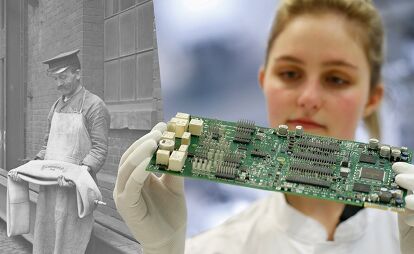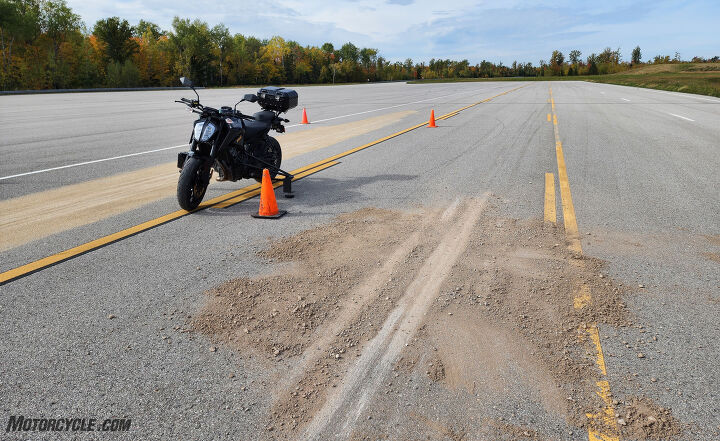Continental AG: So Much More Than Rubber

150 years in the making
Round rolling rubber is Continental’s bag, but it’s not the only one – not by a longshot. You no doubt know Continental for its tires – and you should. Conti has been making tires for more than 150 years spanning nearly every industry. From solid rubber to pneumatic tires and now, tires made from dandelions. Continental has the tire market covered as a major player, but the German company’s emphasis on safety doesn’t stop where the rubber meets the road. Continental takes it more than a few steps further to inform how the rubber interacts with the road. In this day and age, striving to keep folks safe no longer ends at the mechanical traction of a tire. More than ever, companies like Continental are developing highly complex rider/driver aids that range from mild safety intervention to fully autonomous driving.
To showcase Continental’s dedication to two wheels, the folks in the Continental Engineering Services (CES) sector invited us out to the company’s Brimley, MI facility for a hands-on test of some of the technologies it has been refining over the past 30 years in real world simulations. We also had the opportunity to get a peek into the processes and components that Continental has on offer to manufacturers and how these systems work together.
Brimley
Riding a motorcycle with outriggers is an interesting experience. Well, it’s fairly normal until you go to turn and run out of lean angle immediately as the outrigger’s plastic puck grinds into the pavement. That said, when digging hard into ABS over loose surfaces the outriggers allow one to focus more closely on the intervention of the anti-lock braking system. ABS systems on motorcycles aren’t new, but these systems are constantly being refined. We had a chance to throw a leg over a KTM 790 Duke with Continental components and software and were turned loose on a few different surface scenarios.
Continental has been investing heavily in automotive electronics since the early 1990s, and by 2007 Conti had become one of the top five automotive suppliers in the industry. Through development of its own and acquisitions of other specialized companies, Continental has significantly ramped up its involvement in developing solutions for complex vehicle functions like the myriad of advanced driver assistance systems found in automobiles today. These days, Conti’s supercomputer helps develop AI which will in turn help the company pioneer future technologies in assisted, automated, and autonomous driving, further bolstering its core competencies in software, networking, and system architecture. Some of these systems will trickle down to powersports as well, but they will need to be vetted in order to ensure they work in a two wheel application.
The Continental Engineering Services group is heavily involved in R&D and helps take on projects that might be deemed riskier or simply on a smaller scale than the company as a whole would typically be interested in. This could be helping a startup motorcycle manufacturer develop and implement systems in new ways with existing Conti products or even helping to develop products to fit new applications. CES can provide support anywhere from consulting all the way to development and integration and prototype testing.
Our exercise of hard braking on the Conti testing grounds didn’t provide anything mind blowing, as we generally test ABS systems on every motorcycle that comes through the MO stable, but having a chance to test the ABS systems on sand and gravel was a bit more interesting. Perhaps more so, testing ABS in the transition between asphalt and gravel or sand really drilled home the importance of these technologies.
Naturally, a large patch of construction sand vastly increases your stopping distance, but with the Conti braking systems on the KTM we were piloting, its intervention was so precise that it actually stopped quicker than I thought. The test engineers running our exercises told us if the coefficient of friction for asphalt is 1, then the sand would be 0.4 (thankfully they didn’t try to explain the formula for the physics making up these numbers).
It was the scenario of say, coming around a corner to find a large patch of dirt and rocks on the other side while Bambi’s crossing the road that was the most eye-opening. We would push over 40 mph, brake hard enough to trigger ABS prior to the patch, and then feel how the ABS changed from clean asphalt, to dirt, and back to clean asphalt.
The quickness with which the ABS pulsing changed from rapid, to slightly slower, back to rapid resulted in an impressively quick stop. During our sand testing I had the front wheel push slightly, but the outrigger pucks never touched down during any of the exercises while I was purposefully being ham-fisted with the brakes.
It’s these scenarios in which this technology makes riders safer. On a race track, even being the novice around here, I can find ABS overly intrusive sometimes, but on a dark mountain road full of gravel and wildlife, or lane-splitting down the 405, there are more times that I think I would be happy to have the system watching my back. It wasn’t long ago that some of these systems could do odd things over bumpy surfaces and other situations that would have me second guessing them, but with companies like Conti constantly striving for refinement, it’s pretty cool to see how things have changed in less than 10 years.
We also had a chance to check out Continental’s rear facing radar technology fitted to a Harley-Davidson Sportster. The radar would actuate lights on the mirrors to let the rider know there is someone in their blindspot. This is of course already a production feature on a few motorcycles with radar tech like the Ducati Multistrada. Conti mentioned there is plenty of capability and versatility with this system including alerts for vehicles closing with higher approach speeds. This information can be fed to the rider via lights, audibly, or haptically – those decisions are left up to the client/vehicle manufacturer. I was followed by a Can-Am Spyder around a curve simulating an on ramp and the light reliably stayed on despite pushing the Sportster to the limits of its lean angle (which we all know isn’t much).
Later in the day, we ripped around a coned-off course to sample a Continental map on the 790 that the engineers called a “road” map – something for everyday use. The reps told us they had smoothed out the throttle both in general and when receiving abrupt inputs. All of this torque control was achieved by using Continental’s brake controller IMU. Grabbing a handful of throttle at lean resulted in a progressive gradual pick up of power rather than a highside (thankfully), and abrupt throttle chops at high rpm were significantly smoothed out. When riding the bike at a hotter pace higher in rpm, you could feel exactly where the system was working to smooth things out. In some ways it reminded me of the smoothness of Evans’ 790 after adding the Power Commander V.
Continental can provide highly modular systems to its clients, leaving the manufacturer to choose how the system is implemented and marketed. Any company in this realm will work with a manufacturer to supply technology, but much of it is up to the manufacturer in the end. So when you and I see the implementation, most of it has been decided upon by the OEM. Continental can provide three pieces of hardware: a braking systems controller, wheel speed sensor, and sensor cluster (including an IMU) which can run systems through a CANBUS network that include ABS, cornering ABS, traction control, engine drag control, wheelie control, launch control, and rear wheel drift.
It would have been great to get more time with the folks in Brimley to discuss so much of this even further, but as it was scheduled, I spent more time traveling than on the ground by the Canadian border. The takeaway was that the folks we met with were all genuinely interested and happy to be doing what they’re doing, and in CES, they have the ability to pivot and try new things with the backing of an industry-leading worldwide company. Everyone we talked to was emphatically enthusiastic about their job and sharing their time with us.
While I’m not sure if I’m ready for assisted braking, or autonomous motorcycles (what’s the point?!), as technology becomes more refined and the boundaries are pushed, we’re all the better for it. Radar systems and the latest in rider aids help make riding motorcycles safer and in many ways more fun. As long as we continue to have the adjustability to these systems that many modern motorcycles offer, I look forward to what the future holds. Companies like Continental no doubt have plenty more for us to look forward to in the coming years.
We are committed to finding, researching, and recommending the best products. We earn commissions from purchases you make using the retail links in our product reviews. Learn more about how this works.
Become a Motorcycle.com insider. Get the latest motorcycle news first by subscribing to our newsletter here.

Ryan’s time in the motorcycle industry has revolved around sales and marketing prior to landing a gig at Motorcycle.com. An avid motorcyclist, interested in all shapes, sizes, and colors of motorized two-wheeled vehicles, Ryan brings a young, passionate enthusiasm to the digital pages of MO.
More by Ryan Adams











































Comments
Join the conversation
The best ABS is the ABS that does nothing at all until it is absolutely needed to intervene to prevent a lockup. If Continental can continuously improve its ABS in that regard then Kudos are warranted.
The whole idea of blind spot monitoring and the like is a bit over the top for bikes. If you get to the point you can't turn your head quickly to check your blind spot before charging lanes, it might be time to stick to 4 wheels.
"I'm sorry Dave, but you're riding like an idiot. You have one mile to find a safe place to park before the engine is shut down. Have a nice day."